‘It’s time for you to read the Belgian,’ [Pablo Neruda] said forcefully. ‘Because if poetry transports us to the heavens, crime novels plunge you into life the way it really is; they dirty your hands and blacken your face the way coal stains engine stokers on trains in the south, where I was born. I’ll lend you these volumes [by Simenon] so you can learn something from Inspector Maigret. I don’t recommend that you read Poe… [or] Conan Doyle, Sherlock Holmes’s literary father…They couldn’t solve even the simplest case here, in our chaotic Latin America.’
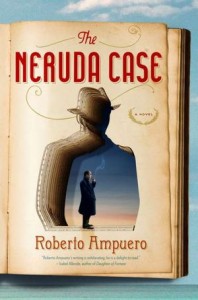 Cayetano Brule, an unemployed Cuban who is living in Valparaiso with his well-connected Chilean wife, escapes the tedium of a cocktail party one evening by disappearing into the library of the estate where the party is being held. Appropriating a wing chair, he begins to muse, perhaps even doze, until he hears footsteps behind him. Hoping to avoid chatting with someone, he remains silent until the intruder begins to comment on the indignities of old age – in such vivid terms that Cayetano wonders if the man might be a writer. The old man confirms this, commenting on Cayetano’s own “detective skills” and introducing himself as “Ricardo Reyes.” When Cayetano turns around, he finds himself staring at Pablo Neruda, real name Neftalí Ricardo Reyes Basoalto, who had won the Nobel Prize for Literature in 1971, just two years before. “He had never been alone with a Nobel laureate before. Emotion suddenly shook his body, and blood rushed to his head.” And when the poet then invites him to come to his home, La Sebastiana, to see some post cards of Havana, Cayetano is so shaken that he waits until Neruda contacts him again before accepting. On his visit to Neruda, he learns that Neruda has a mission for him, his first job as a private detective – to find a man Neruda has not had contact with for over thirty years using skills he must learn through reading Simenon’s Maigret novels and through on-the-job training.
Cayetano Brule, an unemployed Cuban who is living in Valparaiso with his well-connected Chilean wife, escapes the tedium of a cocktail party one evening by disappearing into the library of the estate where the party is being held. Appropriating a wing chair, he begins to muse, perhaps even doze, until he hears footsteps behind him. Hoping to avoid chatting with someone, he remains silent until the intruder begins to comment on the indignities of old age – in such vivid terms that Cayetano wonders if the man might be a writer. The old man confirms this, commenting on Cayetano’s own “detective skills” and introducing himself as “Ricardo Reyes.” When Cayetano turns around, he finds himself staring at Pablo Neruda, real name Neftalí Ricardo Reyes Basoalto, who had won the Nobel Prize for Literature in 1971, just two years before. “He had never been alone with a Nobel laureate before. Emotion suddenly shook his body, and blood rushed to his head.” And when the poet then invites him to come to his home, La Sebastiana, to see some post cards of Havana, Cayetano is so shaken that he waits until Neruda contacts him again before accepting. On his visit to Neruda, he learns that Neruda has a mission for him, his first job as a private detective – to find a man Neruda has not had contact with for over thirty years using skills he must learn through reading Simenon’s Maigret novels and through on-the-job training.
 Author Roberto Ampuero incorporates within the story of Cayetano’s mission for Neruda both the historical and contemporary history of Valparaiso and the political turmoil that roiled the country from the 1970s – 1990s. A ferocious earthquake in 1906 killed three thousand people and devastated the city, and many more people left the city permanently to avoid the aftershocks. An even greater shock to the city’s economy occurred in 1914, however, when the Panama Canal opened and permanently ended Valparaiso’s prosperity as a resupply stop for trips around Cape Horn. By 1971, when Cayetano himself first arrived in Valparaiso, President Salvador Allende was in the second year of his term as the first Marxist ever to be elected president in open elections. Now, in 1973, both Cayetano and his wife are ardent supporters of the president, as is Neruda, their politics representing an unusual point of view for most western readers. Throughout 1971 – 1973, the time frame of the novel, the government is trying to solve economic issues peacefully, while the army is becoming impatient at the slow pace and what they regard as serious threats to national security. Communist guerrillas further confuse the political situation, as does the United States, which fears a takeover of all of Latin America if the socialists and communists become stronger in Chile. They secretly fund those leaders whose activities seem to be in the best interests of the United States.
Author Roberto Ampuero incorporates within the story of Cayetano’s mission for Neruda both the historical and contemporary history of Valparaiso and the political turmoil that roiled the country from the 1970s – 1990s. A ferocious earthquake in 1906 killed three thousand people and devastated the city, and many more people left the city permanently to avoid the aftershocks. An even greater shock to the city’s economy occurred in 1914, however, when the Panama Canal opened and permanently ended Valparaiso’s prosperity as a resupply stop for trips around Cape Horn. By 1971, when Cayetano himself first arrived in Valparaiso, President Salvador Allende was in the second year of his term as the first Marxist ever to be elected president in open elections. Now, in 1973, both Cayetano and his wife are ardent supporters of the president, as is Neruda, their politics representing an unusual point of view for most western readers. Throughout 1971 – 1973, the time frame of the novel, the government is trying to solve economic issues peacefully, while the army is becoming impatient at the slow pace and what they regard as serious threats to national security. Communist guerrillas further confuse the political situation, as does the United States, which fears a takeover of all of Latin America if the socialists and communists become stronger in Chile. They secretly fund those leaders whose activities seem to be in the best interests of the United States.
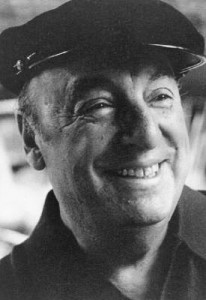
Pablo Neruda
As Cayetano tries to fulfill his task on behalf of Neruda, he travels throughout Mexico, Cuba, East Germany, and Bolivia, and on each stop, as he interviews people from teachers to archivists in his search for Dr. Angel Bracamonte and his family, he evaluates their lives and instinctively observes their relationships to their governments. Cayetano is desperate to help Neruda, who is obviously dying of cancer, and Bracamonte is or was an oncologist Neruda once met in Mexico City, a researcher on the medicinal properties of plants which native peoples have used traditionally for treating cancer. Ironically, Neruda does not want to find Bracamonte for his medical skills. He has a much more personal reason for locating him. As Cayetano uncovers aspects of Bracamonte’s life, his search expands to other members of Bracamonte’s family who live in other parts of the world, and as Cayetano travels to each place unable to reveal anything about his mission to the people he needs to interview, he is often in danger, is frequently followed, and is arrested, jailed, and beaten. Though he sometimes resorts to tactics he has learned from Simenon’s Maigret, Cayetano’s biggest skill is one he shares with Neruda himself – he is a Latin lover extraordinaire.
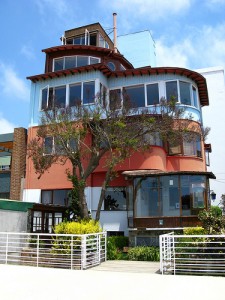
Home of Pablo Neruda
Stylistically, the novel is sometimes baroque, with details presented through phrases, clauses and parallels presented in long series. Complex sentences florid with adjectives and infinite details give a sense of specificity to places and characters, and Cayetano frequently reveals his own conclusions about women’s appearances, and what might lie hidden beneath the surface. Often humorous and full of ironies, Ampuero’s conversational style makes Cayetano a charming narrator, even though his womanizing gets tiresome, at times, and Neruda’s many affairs begin to pall. Each of the five sections of the novel is named for a woman who has been important to Neruda over the years and includes their love story, told in Neruda’s own words. “Machismo” takes on new meaning as these two dedicated philanderers work their magic.
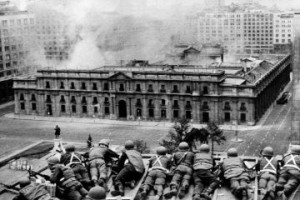
Pinochet coup, Sept. 11, 1973
The mystery itself moves along leisurely in a straight narrative format – from this place to the next place, to the next place, and to the next – with the new information being incorporated into the framework of the novel while the author is also including information about the changing political situations in various countries and commenting on his characters’ love affairs. At times the reader may wish that Cayetano’s search had been compressed so that it does not feel “thready” and lacking in impact. The digressions on Bertoldt Brecht, for example, and the visit to his grave while Cayetano is in East Germany are interesting and are connected thematically, but they are not essential, add nothing new, and feel unnecessary. As Cayetano’s search winds down and the tensions in Valparaiso and Santiago reach the breaking point, the various aspects of the novel come together in revolution, the effects of which devastate Chile for almost two decades, only to be rejected ultimately in favor of democracy. The Marxist trichotomy – thesis, antithesis, and synthesis – plays itself out here, for now….
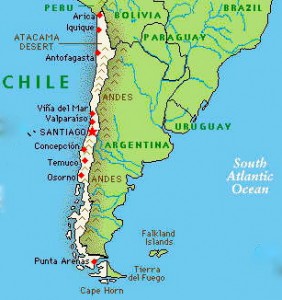
Photos, in order: The author’s photo is from http://www.elclarin.cl
The photo of Pablo Neruda appears on http://www.mondolatino.it
La Sebastiana, Neruda’s house in Valparaiso, referred to as a “polychrome pyramid,” is now a national monument. Its history and this photo may be seen here: http://teacherontwowheels.com
On September 11, 1973, Chilean army troops fired on the Presidential Palace, La Moneda, and overthrew Salvador Allende with the aid of the U.S. Gen. Augusto Pinochet became president and remained in power until a referendum in 1988 showed that the country wanted more democratic rule. The photo of the attack in 1973 is from http://www.globalpost.com
The map of Chile is posted on http://wwp.greenwichmeantime.com
ARC: Riverhead
